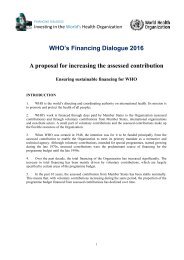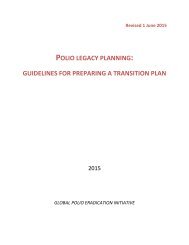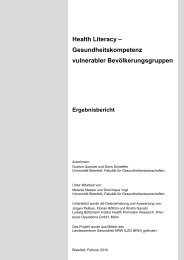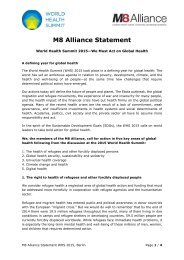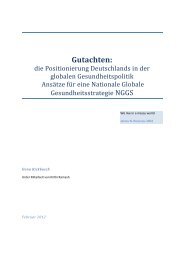Tackling-health-inequities-from-concepts-to-practice-The-experience-of-Vastra-Gotaland
Tackling-health-inequities-from-concepts-to-practice-The-experience-of-Vastra-Gotaland
Tackling-health-inequities-from-concepts-to-practice-The-experience-of-Vastra-Gotaland
- No tags were found...
Create successful ePaper yourself
Turn your PDF publications into a flip-book with our unique Google optimized e-Paper software.
problem with <strong>health</strong> inequalities became more visible (3). Regional reportsstating the costs and existence <strong>of</strong> <strong>health</strong> inequalities as well as initiatives withinthe Region provided even more insight (2). As the problem <strong>of</strong> increasinggaps in society grew clearer and the public awareness stronger, there waspolitical will <strong>to</strong> act. Lastly, as can be seen below, different departments (thatwould become connected <strong>to</strong> the work within the Commission) were alreadyprepared <strong>to</strong> work <strong>to</strong>wards a comprehensive policy.In the WHO report (8), five reasons for working with <strong>health</strong> equity are listed,varying <strong>from</strong> the individual rights perspective <strong>to</strong> economic incentives. As acomplementary explanation <strong>to</strong> the question <strong>of</strong> “Why now?”, the regionalorganizations had clearly taken steps <strong>to</strong> recognize the reasons. For example,the creation <strong>of</strong> a Human Rights Committee had put focus on the humanrights issue; the social risks were becoming more present and were alreadyaccepted by national authorities as well as regional bodies as valid risks; and,finally, the connection between <strong>health</strong> equity and societal resources andsustainability had been established.Understanding the results<strong>The</strong> work <strong>of</strong> the Commission has a clear connection <strong>to</strong> what Callon callsnetwork formation (19, 21). By using the four “moments <strong>of</strong> translation”,some major decisions as well as outcomes become more visible and easy <strong>to</strong>understand.Problematization focuses on the question <strong>of</strong> who was included in thenetwork, which in turn is a result <strong>of</strong> how the purpose and scope are presentedand communicated. Public <strong>health</strong> work in Västra Götaland has a long his<strong>to</strong>ry<strong>of</strong> intersectional organizations, with public as well as civic organizations. <strong>The</strong>Steering Group consisted <strong>of</strong> regional politicians who were commissioned<strong>to</strong> participate. <strong>The</strong> level <strong>of</strong> knowledge and interest in the area <strong>of</strong> socialsustainability and <strong>health</strong> equity varied, which can be seen both in theattendance records as well as the political discussions that arose during thedecision phase. <strong>The</strong> workgroup was principally a network <strong>of</strong> stakeholderswho attended on a voluntary basis. Most <strong>of</strong> the representatives already had aninterest in public <strong>health</strong> and could easily recognize the problematizations.However, the concept <strong>of</strong> <strong>health</strong> inequalities proved <strong>to</strong> be an obstacle <strong>to</strong> fullSection 4. Addressing <strong>health</strong> <strong>inequities</strong> in Västra Götaland25




